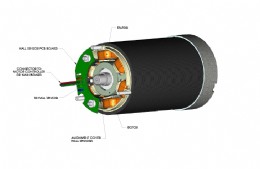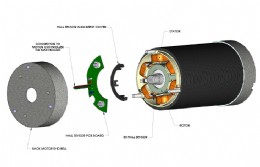The Use of Brushless DCV Motors in Electronic Valve Actuators
Prepared by: Earnest Carey, Jr. and Scott Wilkerson

Limitorque actuator installation

Figure 1: Typical BLDC motor

Figure 2. Components of the BLDC motor
Safety and efficiency are two non-negotiables in the control of plant systems. Each field device must not only meet, but exceed the requirements of users’ specifications. The growth of fieldbus technologies has enabled visibility of real-time component performance and the need to optimize networked response. This means that previously accepted levels of performance for the electric actuator are being replaced by expectations for better precision, safer and quieter electrical operation, and improved longevity. All of these attributes are included in an electronic valve actuator with BLDC motor technology.
Flowserve has been a pioneer, particularly with the Limitorque brand, in product development technologies that are new to electric actuation. BLDC motors have been in use for about 50 years but just recently have been employed in smart actuation. Their adaptation is key to improving process control and plant safety systems. Advantages include:
Low maintenance (no brushes)
- Variable operating speeds and fast response times
- High efficiency, resulting in cooler performance
- Compact size
DCV and ACV motors were developed in the 19th century, and ACV quickly became the preferred motor for converting electrical energy into mechanical force. Some users still prefer the DCV motor, but they require more maintenance due to susceptibility of the commutator assembly (brushes) to increased wear.
Several innovations through the years improved the efficiency of brushed DCV motors. The search to eliminate brush deterioration contributed to a significant breakthrough in 1962, when the motor commutator was replaced by a revolutionary new design, using solid state commutation. Because of stringent aerospace requirements for safety and reliability, BLDC motors with new and improved drive systems were developed. This technology was utilized in the Apollo space program in life support systems.
BLDC motors were, at first, limited to about 0.373 kW (0.5 hp), but today motors up to 100 kW of power are available. They are routinely used in computers and spindle drives in CNC machine tools, typically any application that demands a high degree of positioning accuracy. Their performance characteristics exceed ACV motors in efficiency, starting torque, size to power ratio, and in speed and position control. Since 2007, several electronic actuator OEMs have designed new products with BLDC motors.
Reasons to Use BLDC Motors in Smart Actuators
To meet user demand for safe and reliable electronic control, smart electronic actuators were developed approximately 20 years ago. BLDC motors use sophisticated electronics such as motor controllers for control and safety. When communicating with mating motor controllers and other processors, BLDC motors offer superior performance and reliability — in addition to accurate speed control and precise valve positioning.
A disadvantage to using BLDC motors in actuators has been their higher cost when compared to ACV motors. The cost-tobenefit ratio has improved over the years, so the technology costs are practically on par with ACV motors. They do require motor controller electronics to drive them, but this too is proving to be an advantage.
A significant feature of the BLDC motor is the use of Hall-effect devices for determining rotor speed and positioning. These devices are fundamental to the performance of the motor because they provide immediate and accurate motor rotor position feedback to the motor controller for the purpose of regulating motor speed. See Figure 2 for an enhanced view of the BLDC motor, Hall-effect sensors, alignment cover and the sensor PCB.
Like ACV motors, BLDC motors operate with variable frequency drives (VFD) without the EMI components. A BLDC motor can change its speed rapidly and precisely (e.g., a maximum 3000 rpm motor can vary its speed down to 200 rpm, and subsequently accelerate to 3000 rpm, depending upon a signal received from the motor controller. The speed and actuator position control is also improved when supplemented by encoders.
Absolute position encoders are essential components used to determine both actuator speed (rpm) and exact position. Absolute encoders in actuators should have at least a resolution of 12 to 18 bits for precise positioning. An actuator with a BLDC motor that incorporates encoder feedback appreciably enhances the device’s ability to control both speed and position.
Another benefit of a BLDC motor is its ability to operate on both AC and DC main voltage. A typical BLDC motor is powered by a DC voltage bus. Since the vast majority of global voltage inputs are AC, a rectifier is required to create the DC voltage bus. The electronics must have the capability to rectify both singleand three-phase AC voltage inputs up to 600 VAC, as well as down to the BLDC motor bus voltage. Additionally, it should be able to support direct DC voltages of 125 to 250 VDC, and boost a 24–48 VDC site input up to the BLDC motor bus voltage. The use of 24–48 VDC is important for alternative energy such as the solar power industry or industries that use solar power as a primary power source.
As previously mentioned, electronic motor controllers are used to drive BLDC motors and are sized to match the power capability of the motor. While the motor operates cooler than other motor types, the thermal transfer of the motor’s power produces heat in the motor controller, so sufficient thermal “chill” is needed to dissipate the heat. A wellengineered motor controller design includes heat dissipation.
BLDC motors can be used for virtually any global voltage requirement for On/Off valve control. However, the primary benefit is in process control applications. Electric actuators are equipped with an internal 4–20 mA controller that corresponds to a process position signal received from plant instrumentation for “modulating” applications. Initially, performance was limited to about 60–100 motor contactor “starts” an hour, but today many processes demand 1200–3600 “starts” per hour. As a result of the increased requirements, there can be significant stress to the motor and actuator drive gearing.
One of the advantages of BLDC motors is its ability to operate cooler than ACV motors, due in part to the absence of brushes (friction) and their smaller size per torque output ratio. The ability of BLDC motors to run cooler and mitigate heat rapidly, while operating almost continuously, is critical to an electronic actuator exceeding 1200 starts per hour.
Finally, no brushes mean sparks are not generated, solving a major problem with DCV brushed motors: brushes generate electrical noise that causes EMI. A BLDC motor uses electronic sequencing of motor current in lieu of troublesome brushes. The elimination of sparks makes them more suitable to comply with global explosion-proof certifications. EMI reduction is important because it satisfies certain European directives which have stringent conducted and radiated emissions envelopes.
In conclusion, in plant systems requiring increased levels of safety and control, users should consider BLDC-powered actuators. They are safe, due to the absence of brushes and cooler thermal characteristics. They are reliable, due to the evolution of their design over the past 50 years, and are used in industries such as the U.S. Space program as well as heavy machine tools. Finally, they are predictable, especially when coupled with electronic systems that work in concert with motor controllers and encoders. Although their use in electronic actuators is relatively new, their advantages will contribute to a growing number of users preferring BLDC motors in the coming years.
Flowserve Flow Control (UK) Ltd
Tel: 01444 314400
www.flowserve.com

| Telephone: | 01444 314400 |
| Email: | ukfcinfo@flowserve.com |
| Website: | www.flowserve.com |
| More information on the Flowserve Flow Control (UK) Ltd BVAA Member Directory Page |
Search related valve / actuator articles: Flowserve Flow Control (UK) LtdIssue 24Electric ActuatorsMaster Class












